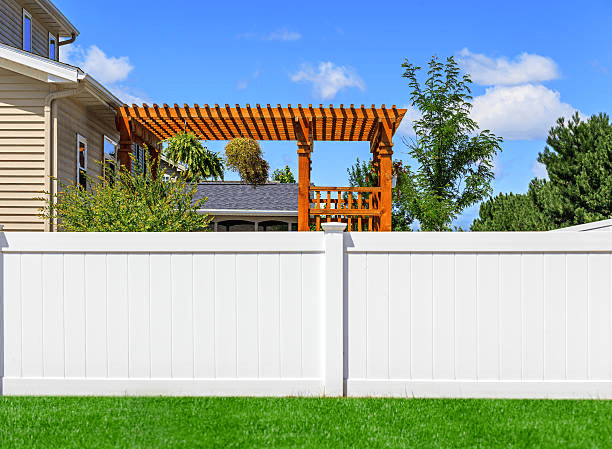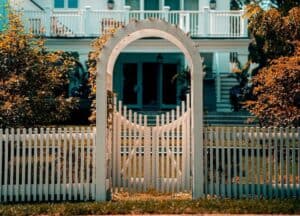The most popular and go-to choice for fencing is vinyl fencing. This is because vinyl is highly functional, durable, affordable, and attractive. Vinyl fence is also the best thing to ensure your privacy. Vinyl fences do not rot or bend down just like wood fences.
Black Vinyl fences are available in a lot of options like wood vinyl fences, vinyl-coated chain link fences, and a lot more. There are many benefits of vinyl fence installation but they do not go all the way to the ground. Because it is all the same height, any uneven area of your yard and/or slope will result in a gap between the ground and the bottom of the fence. Even if your fence is erected on level ground, there will be some gaps. This can make small animals or debris enter your yard.
Before you start fixing the gap under your white vinyl fence, you should figure out what’s causing it. In other circumstances, the fence may have been erected incorrectly, resulting in gaps over time. In this instance, you might need to engage an expert to reinstall the fence.
Fortunately, several techniques can be applied to fill the gap under your vinyl fence. This makes your yard completely safe and clean.
Use gravel or rocks

The easiest way to fill a gap under your vinyl fence is using gravel or rocks. You have to start by creating a trench along the fence line that is deep enough to hold the gravel or rocks. Then, in the trench, lay down a layer of landscape fabric to keep weeds from growing up through the rocks.
You can fill the trench with gravel or rocks, firmly tamping it down to avoid settling. After filling the trench, use a rake or shovel to smooth off the surface and ensure it is level with the ground.
Stepping
Stepping is one of the common ways to place a vinyl fence in a sloping yard. This strategy simply means that instead of setting up the fence so that it is even at the top, you line it up so that it is even with the ground as it travels down the hill.
It is best if you lower the fence at the same rate with each panel. If you lower one panel by three inches, lower the following panel by the same amount, and so on. There should still be some space between the ground and the bottom of the fence when employing this method. However, it should prevent the gap from widening as it descends the slope. The best part about this technique is that it doesn’t require any additional materials, so the stepping method is free of cost.
Install a concrete footer

Another effective way to fill a gap under the vinyl fence is by installing a concrete footer. This technique is useful for areas where there is soil erosion or for larger gaps.
For installing a concrete footer, start with digging a trench along the fence line. Make sure the trench you dig is deep enough to accommodate both the concrete and a layer of gravel or crushed stone. Next, cover the trench with garden cloth to prevent weeds from sprouting through the concrete.

Pour the concrete into the trench after mixing it according to the manufacturer’s instructions. Smooth out the surface of the concrete with a trowel, making sure it’s level with the ground. Allow the concrete to completely dry before putting up the vinyl fence panels.
Use Dirt or Mound
The dirt or mound approach is just as it sounds. Simply fill the space under the fence’s bottom with dirt or a mound. To be successful, the soil must be packed securely into the space. This is the best option if you just want to get rid of the gap since it looks bad. It is also quite simple to move or modify dirt mounds if you ever need to relocate or remove your fence.
However, if you’re trying to keep a pet, such as a dog, in the yard, this strategy is unlikely to work. The same is true for any type of animal you want to keep out of your yard, such as a mole.
Use a Foam Backer Rod

A foam backer rod is a flexible foam-based material that can be used to fill gaps beneath a vinyl fence. It’s especially useful for minor gaps or regions where soil erosion isn’t a major issue.
To begin using foam backer rods, measure the gap under the vinyl fence. Insert a piece of foam backer rod, cut to the right length, into the gap. Push the foam backer rod firmly into the gap with a putty knife, making sure it’s flush with the ground.
Once the foam backer rod is in place, apply a bead of silicone caulk along the top of the foam with a caulking gun. Allow the caulk to dry after smoothing it out with a putty knife.
Install a Barrier

Another alternative is to attach a barrier of some kind to the bottom of the fence. Typically, when using this method, the vinyl fencing is aligned such that each piece is even at the top. Then, bolt pieces of vinyl or other material to the bottom of the fence to fill in any gaps that occur.
This strategy is inexpensive and efficient for keeping animals in — or out — of your yard. It can also be moved or altered in conjunction with your fence as your requirements change.
Conclusion
When you search for vinyl fence installation near me, make sure you find the right installers. It is important to get your fence installed properly to save your time and money in the long run. Regardless of the method used, it is critical to fill gaps under vinyl fences as soon as possible to prevent further damage and preserve the fence’s longevity. Homeowners may maintain their vinyl fences and enjoy their numerous benefits for years to come by following the mentioned techniques.
